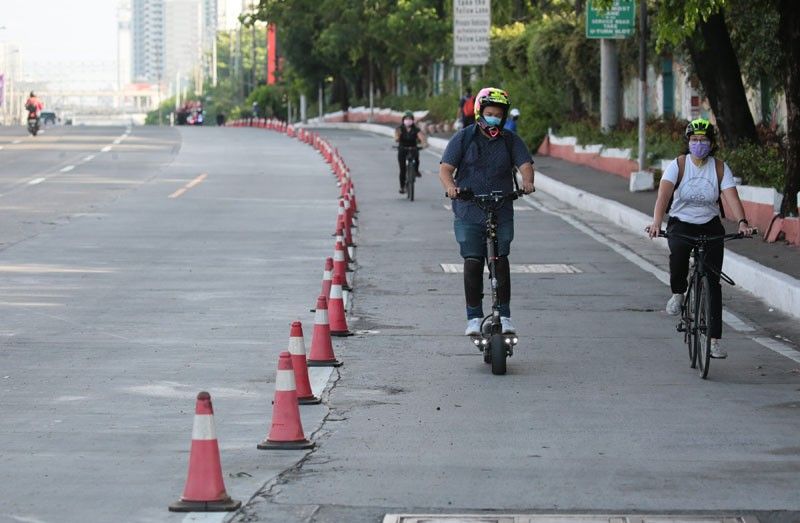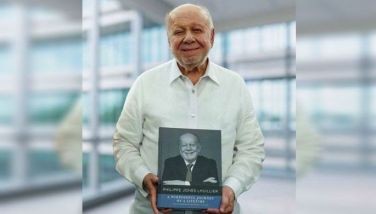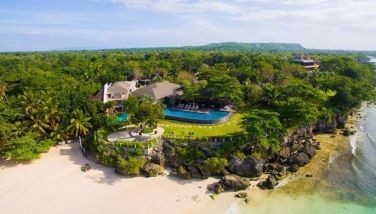On World Bicycle Day, transport group says Filipino cyclists 'should arrive alive'

MANILA, Philippines — A transport group on the celebration of World Bicycle Day on Thursday urged the administration to build protected bike lanes that save lives and ensure that "Filipino cyclists arrive alive."
In a statement sent to reporters, the Move as One transport coalition urged the national government to incorporate active transport infrastructure in P264-billion worth of DPWH roads and bridges as required under the 2022 budget.
The coalition pointed out that the number of households with bicycles in urban areas and NCR more than doubled this year with two of five cycling households now riding more frequently according to a survey by the Social Weather Stations.
"Indeed, many Filipinos discovered the joys of cycling during the COVID-19 pandemic, [but] too many cyclists are dying on Philippine roads due to the lack of protected bike lanes," the statement reads.
"Filipino cyclists should arrive alive...We demand more than just thoughts and prayers from the government for the cyclists who have died on our unsafe roads."
From 2019 to 2021, the Metro Manila Development Authority data reported a total of 82 cyclist deaths and 4,588 injuries. News reports on the incident highlighted the issue of drunk driving and frame some of them as accidents that just happen. But the cycling community says it’s time to classify them as “crashes” or traffic violence."
This, despite supporting legislation in the 2022 General Appropriations Act pushing for the continued construction of active transport infrastructure, including:
- DPWH Special Provision 8 requiring the DPWH to build active transport facilities in all road and bridge projects,
- DOTr Special Provision 7 allocating P2 billion for active transportation facilities and requiring at least 50% of road space to be allocated for public transport, pedestrians, and cyclists
- Local Government Support Fund Special Provision 2 allows local government units to apply “protected bike lanes and better pedestrian infrastructure” for funding
- MMDA Special Provision 3 directs the Metro Manila Development Authority to include “people mobility programs” prioritizing non-motorized transportation under Traffic Management Program budget
"Cyclists who are the main breadwinners and who die on the road leave their families with a huge emotional and financial loss," Move as One said.
"Those who suffer injuries require surgery, physical therapy, and time to recuperate. Often, they cannot afford the medical expenses and lost income when they miss days at work."
The United Nations declared June 3 World Bicycle Day to acknowledge that the bicycle “is a simple, affordable, reliable, clean and environmentally fit sustainable means of transportation, fostering environmental stewardship and health.”
"Nurses, doctors, healthcare workers, frontliners, workers, students, teenagers, and professionals are among the road crash victims," Move as One also said.
READ: With transport groups protesting possible second term, Tugade says DOTr 'delivered'
What has the government done for cyclists?
At Day 1 of the Duterte Legacy Summit at the Philippine International Convention Center on Monday, transportation secretary Arthur Tugade brought up the 563-kilometer bike lane networks constructed in Metro Manila, Metro Cebu, and Metro Davao in arguing that his department "delivered" during its six-year term.
"Happy na happy ang mga bikers...this is not just a good mode of transport but also a safe one," Tugade claimed.
The biking community has said that while the largely rudimentary bike lanes are a good start in terms of coverage, many still feel unsafe traversing the metro's hectic roads, which still see mostly car-centric policies and enforcement.
In an interview with Philstar.com, Edison "Bong" Nebrija, head of the Metro Manila Development Authority's Task Force Special Operations said that education of cyclists and stricter enforcement were still needed to make bike lanes safer.
"I think there are a lot of education that needs to be put in whether formal or informal. Do your friend a favor, teach him not just how to bike but how to bike safely," he said in mixed Filipino and English. "There's so much more to teach the people who are biking."
The former MMDA traffic chief framed extra equipment such as helmet, shades, gloves, vests, and lights as being necessary for bikers to ride safely in the metro's hectic roads. He also proposed the government should look into issuing licenses or certifications for biking, or even bikers education courses.
But the Vienna Convention on Road Traffic, which the Philippines is a signatory of, says no party shall require the drivers of cycles in international traffic to hold a driving permit.
"The mindset itself is not yet right for bikers to ride on the highways," Nebrija went on to claim. "We also see that it's dangerous to put [the bike lanes] at grade with motor vehicles [but] we did not see any other places to put them."
Advocates have also pushed back against what they say is the outdated narrative that biking is an inherently dangerous thing to do, which they say takes the focus away from the reality that the roads are lacking infrastructure amid the car-centric culture.
In an earlier interview with Philstar.com, active transport advocate Anton Siy, Pasig City's chief transport planner, said that this narrative isn't backed by data nor experience around the world.
"There's so much obsession about how to ride safe, you know, always wear a helmet wherever you go. things like that. But then you look at other countries like Japan and the Netherlands and almost nobody wears a helmet there and you barely have any cycling deaths," he said.
"It's because, you know, cycling isn't really inherently dangerous. And it only becomes a dangerous activity when you when you're cycling in the middle of speeding motor vehicles, whose behavior is not kept in check by infrastructure or any kind of law enforcement."
Siy said that part of this narrative is cultural, as the number of cyclist accidents in the news only contributes to the misplaced fear of cycling instead of the fear of the road conditions.
"It's not an activity that's inherently dangerous. But it's made dangerous by the conditions where we're asking cyclists to mix with road users at high speed," he said.
"How do you take the conversation from that? Instead of telling cyclists to look out for themselves, basically taking that energy to officials to ask them to design better streets for the cyclists in your life, that are just trying to get around so that you don't have to worry for their safety anymore?"
- Latest
- Trending
































